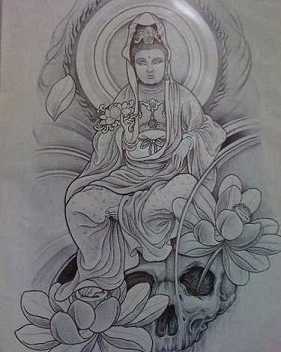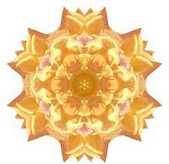浸于身内
发布时间:2023-02-14 15:01:18作者:准提咒在线网浸于身内
[作者]坦尼沙罗尊者
[中译]良稹
Immersed in the Breath
by Ven. Thanissaro Bhikkhu
Some people think that when the Buddha describes the five aggregates he’s describing what we are, but that’s precisely what he’s not saying. He’s saying that we’re not that. But the mind does identify with these things—sometimes with the body, sometimes with feelings, perceptions, thought-formations, sometimes with sensory consciousness, sometimes different combinations, sometimes all of the above. If you could take a movie of the mind’s sense of itself, it would be erratic and mercurial, like a reflection on water—slithering here and there, identifying with this, identifying with that, shape‐shifting all the time. In changing position all the time like this, the mind expends a lot of energy. One of the things that we want to try to do as we meditate is to get it to stay in one place, to save some energy. As long as you’re going to have a sense of self, keep it solid—rock solid—immersed in the body.有些人以为佛陀描述五蕴时,他是在描述我们是什么,然而,那与他的话恰恰相反。他是说,我们不是它。不过,心的确认同这些东西——有时认同的是身体,有时是感受、辨识、思维造作,有时是感官意识[色受想行识],有时是不同的组合,有时是上面说的全部。如果可以给心的自我感拍一部电影,它的样子会是漂泊不定、擅变无常,就像水中的倒影——滑到这里、滑到那里,认同这个、认同那个,时时刻刻都在变形。在这样一刻不停地改换位置的过程中,心耗费了大量的能量。我们禅定时需要试着做的,是令它呆在一个地方不动。只要你还有一个自我感,就把它沉浸在身内,保持它的坚固——如盘石般坚固。
Breath meditation is one way of staying immersed in the body. The term in Pali is kayagatasati, mindfulness immersed in the body. And the quality of immersion is important. You want to fill the whole body, occupy the body, inhabit the whole body, as much as you can.出入息念,就是浸于身内的一种方式。巴利语是 kāyagatāsati——念浸住于身内[身念住]。浸住这个素质是十分重要的。你要尽可能地填满全身、占据身体、遍居全身。
Where is your observer right now? For many of us, it’s like a weird bird perched on our shoulders and peering through our eyes. It watches the body as if the body were something separate. But as we meditate, we’re trying to get away from identifying with that particular observer; we want to be an observer filling the whole body. Your feet fill your feet, your hands fill your hands. Your entire sense of who you are fills the entire body.现在,你的观察者在哪里? 对我们许多人来说,它就像一只栖息在肩膀上的怪鸟,透过我们的双眼在注视。它看身体,是把它当成某件分立的东西来看的。不过,禅定时,我们是在尝试脱离与那个观察者的认同; 我们要做一个占满全身的观察者。你的脚占满你的脚,你的手占满你的手。你的整个自我感占满整个身体。
This puts you in a position of strength, because if you’re leaving big gaps of unoccupied territory in your body, other things will occupy it—different thoughts, different defilements. But if your awareness occupies your whole body, other things can’t get in so easily. The image in the Canon is of a solid wooden door: a ball of string thrown at the door won’t leave a dent at all. Even if things do come in and make a dent on the mind, you’re going to know it, you’re going to see it because you’re right there. You’re not off in some other corner of the body looking at something else.这就把你放到了一个有力的位置,因为如果你在身内留下大片尚未占据的区域,其它东西将会占据它——各种思维、各种杂染。不过,如果你的觉知占据了你的全身,其它东西就不那么容易进来了。圣典里的比喻形象是一扇硬木门: 朝那扇门扔过去一个线团,根本不会留下一点凹痕。哪怕其它事物的确进来,在心里制造出一个印象,你也会知道它,你也会看见它,因为你就在那里。你没有跑到身体的另一个角落,去看别的东西。
So as you focus on the breath, try to get past the idea that you’re in one part of the head watching the breath in other parts of the body. You want to occupy the whole body, bathed in the whole breath. The breath and the body should be surrounding your sense of where you are. And then you want to maintain that sense of being centered in the body like this, filling the whole body with your awareness as you breathe in, as you breathe out. 因此,随着你专注气,要试着克服你在头部某个位置看身内其它地方的气这个观念。你要占据全身,沐浴于整个气中。气和身应该包围着你的所在感。接下来,你要维持这样定在身内的那股感觉,随着你的入息,随着你的出息,把你的觉知填满全身。

Why? For one thing, this sense of filling the body helps you stay in the present moment. When the mind goes off thinking thoughts about past and future, it has to shrink its sense of awareness, shrink its sense of itself, down to a small enough dot so that it can slip into the past or slip into the future. In other words, you latch onto the part of the body that you use as a basis for thinking about the past or the future, while other parts of the body get blotted out. But if you’re filling the body with your awareness and can maintain that full awareness, you can’t slip off into the past and future unless you want to. So this is one way of nailing yourself down to the present moment. Your inner hands are nailed to your physical hands, your feet to your feet. You can’t move.为什么? 首先,这股填满全身的感觉,帮助你住于当下。当心跑去思考过去、未来时,它必须缩小它的觉知感,缩小它的自我感,变成小到一个点,才能溜到过去,溜到未来。换句话说,你攀附到体内你用来作为思考过去或未来的立足点的那个部位,与此同时,其它部位却被湮没了。不过,如果你用觉知把身体填满,并且能够维持那个遍觉知,就不可能闪入过去未来了,除非你想去。因此,这是把你自己钉在当下的一种方式。你的内在之手给钉到你的身体之手,你的内在之脚给钉到你的身体之脚。你就不能动了。
Think of the breath coming into the whole body. Every cell of the body is participating in the breathing process, and you’re sitting here in the midst of it. This gives your sense of observing self a greater solidity, so that when thoughts come into the mind you’re not knocked off balance by them. You’ve got a solid foundation. The word they use for the object of meditation in Pali, arammana, literally means “support,” the idea being that your mind is standing firm on something. You’re standing here in the body. This is your location. This is where you take your stance. And when your stance is solid, nobody can kick you over or knock you down.把气想象成进入全身。身体的每一个细胞都参与呼吸过程,而你就坐在其中。这样就给你这个正在观察的自我,赋予了更大的坚固性,以至当诸种想法进入心里时,你不会给它们撞得失去平衡。你有一个牢固的基地。巴利文禅定对象一词, ārammaṇa [所缘],它的严格[字面]意义是“支撑”,意思是,你的心牢牢定立在某件事物上。这里你是定立在身内。这就是你的位置。这就是你确立定姿的地方。当你的定姿牢固时,没有人能把你踢倒或击倒。
It’s like riding on the subway in New York City. The subway sways back and forth and up and down and all around. If your stance is planted just right—so that you don’t get knocked over either by the acceleration or deceleration of the train or the swaying to the left or the riht—you can maintain your balance no matter what. But life is a lot more erratic even than a subway train. The things that happen around you—sights, sounds, smells, tastes, tactile sensations, things that people do, things that people say: They can hit the mind with a lot more violence, with a lot more force than the wobbling or sudden braking of a subway train. So the mind needs a really solid stance.这就好比在纽约市乘地铁。车厢在那里前后、上下、四周摇晃。如果你的立姿正确——你在车厢加速、减速、或者左右摇晃时不会跌到——那么无论发生什么,你都能维持平衡。不过,生命的多变远甚于地铁的摇晃。周围发生的事件——色、香、味、触、人们做的事、人们说的话: 它们撞击你的心,可能会暴力得多、猛烈得多,远远超过地铁车厢的摇摆和急刹的力量。因此心需要一个极其牢固的定姿。
This is why we work on providing this support for the mind not only while we’re sitting here meditating but also throughout theday. Some people complain that it’s asking too much of them to pay attention to the events of the day and to the breath at the sametime. Well, if you’re sitting in the back of your head watching the breath in the body and watching things outside, it does add an extra burden: You’ve got two things to watch at any one time instead of just one. But if you think of yourself as immersed in your body, inhabiting your whole body, this puts you in a different position. You’re standing in the breath, in a position of solidity, a position of strength. From that position you watch things outside, so that instead of having extra things to do, you’ve simply got a better place to maintain your stance. If your sense of self is inhabiting one little part of the body, and things come in from the outside with great force—somebody does something or says something that hits you the wrong way—you can get knocked off kilter really easily because your stance isn’t solid. The mind is so used to flitting around from one position to another that it’s very easily knocked off balance. But if you’re standing, filling your whole body with your awareness—this is your stance, this is your support—then no matter what comes, you can keep your balance.这就是为什么我们要修练为心提供这个支撑,不仅在坐禅的这段时间内,而且终日不失。有些人抱怨说,要自己既关注日常事件,同时又关注气,太难了。当然,如果你是坐在后脑勺里,既要观身内的气,又要看外面的事物,的确是额外的负担: 任何同一时刻你要看的东西不止一件,而是两件。不过,如果你把自己想象成浸住在身内,遍居于全身,就把自己放到了一个不同的位置。你定立在气中,定立在一个坚固的位置上、一个有力的位置上。你从那个位置出发看外面,就不是作额外的事了,你只是处在一个维持定姿的更佳位置上。如果你的自我感,是住在体内某个小小的部位,外面的事物带着强力冲进来——某人做了什么、说了什么,惹到了你——你很容易被撞得失去平衡,因为你的定姿不牢固。心太习惯于从一个位置闪到另一个位置,它极其容易被撞翻。不过,如果你立 定,把觉知填满全身——这就是你的定姿,这就是你的支撑——那么无论来的是什么,你都可以保持平衡。
So try to maintain this sense of inhabiting your body, being bathed in the breath, being surrounded by the breath on all sides, not only while you’re sitting here but also as you go through the day. Try to maintain this quality of being fully immersed in the body, fully aware, fully mindful, fully alert. Once you can maintain this stance in different situations, then you can start observing the sense of self you’ve created here. If your sense of self is flitting all around—first with a feeling, then with a perception, then back to a feeling again, then to perception and feeling, like those weird amoeba-like shapes that flit across the surface of water—it’s hard to observe, to get a sense of, “What is this self? Why does the mind need a sense of self?” But as you maintain this one sense of self inhabiting the body, immersed in the body, surrounded on all sides by the breath, it’s there long enough for you to observe it: What’s it made of? What’s the form here? Where’s the feeling? Where’s the perception? Where are the thought-formations? Where’s the consciousness? It’s all right here, relatively still, enough that you can really observe it. 因此,试着维持这股住于身内之感、浴于气中之感、被气全面包围之感,不仅在这段坐禅时间里,而且随着你度过整日。试着维持这个遍浸身内、遍觉知、遍念住、遍警醒的素质。一旦你能够在不同场合下维持这个定姿,接下来就可以开始观察你在这里造作起来的自我感了。如果你的自我感闪来闪去——先是[认同]某一感受、然后是某个辨识、然后回到感受、接着是辨识连同和感受,就像闪动在水面上的那些古怪的阿米巴变形虫一样的形影——那么“这个自我是什么? 为什么心需要一个自我感?”的问题,是很难观察、很难弄明白的。不过,随着你维持这个遍居身内、浸于身内、周遭被气包围的单一的自我感,你就有足够长的时间观察它: 这是由什么构成的? 这个形色是什么? 感受在哪里? 辨识在哪里? 思维构造在哪里? 意识在哪里? 它都在这里,相对寂止,足以让你真正地观察它。
There are lots of advantages to having a sense of mindfulness immersed in the body, your sense of self immersed in the body. Eventually you take that sense of self apart, but in the meantime you learn how to use it so that you don’t get knocked over by all the winds and currents of the world. You don’t get knocked over by all the currents flowing out of the mind either. When they talk about taking the body in-and-of-itself as your island, as your refuge, this is what they mean: The current of the river flows past, but the island stays solid because it’s deeply rooted. It’s made of rock, like Manhattan; it’s not a sand-bar. You’ve got your awareness deeply rooted in your hands, in your feet, in the different parts of your body, not just in your head, not flitting around from here to there. You’ve got a large sense of awareness filling the present. 有一股念浸于身内之感、“我”浸于身内之感,是有许多好处的,最终你要把那个自我感拆解开来,不过现在这个时候,要学会利用它,使你不被世间各种风潮撞倒。也不被外流的各种心流撞倒。经典中谈到以身为岛屿、以身为依止时,就是这个意思: 河水奔流而过,岛屿坚固不动,因为它的根基深厚,它由盘石构成,一如曼哈顿岛; 它不是一块沙洲。你已经把觉知深深地扎根在你的双手、你的双脚、你的身体的各个部位,而不是单单住在你的头部,不会从这里到那里乱闪。你就有了一个填满当下的扩大的觉知。
This puts you in a position of strength, which you want to maintain for as long as you can. It helps ward off the currents that come flowing from outside or inside, and it also allows you to see your sense of self a lot more clearly, to understand what it is—where there’s still suffering even in this position of strength, where there’s still stress and uncertainty and inconstancy. But first you do your best to make it constant. How are you going to believe the Buddha’s teachings on inconstancy until you’ve found some constancy in your awareness? You push the limits. It’s only when you really push the limits that you can gain a true sense of where things start pushing back. When the Buddha gave his teachings, he didn’t simply ask for people to believe what he said. He said to push back inside yourself to test them.这就把你放在一个有力的位置,你要尽可能长久地维持它。它助你抵挡各种来自外在、内在的激流,它也让你以高得多的清晰度看见你的自我感,领悟它是什么——看见即使在这个有力的位置,哪里还存在苦,哪里还存在张力、不确定、无常。不过,首先你要尽量地做到使它恒常。你怎么能相信佛陀的无常教导,除非你已经在自己的觉知中找到了某种恒常? 你要力推极限。只有你真正力推极限时,才能真正懂得事情在哪里开始反推。佛陀传法时,并非是只要人们信他的话。他说,在你的内心对它们作反推、作检验。
So. Inconstancy, stress, not-self: How do you test those? By creating a constant sense of ease in the body, because this awareness has to be relaxed in order to last. And you can identify with it, inhabit it fully. It’s only in this way that you can push against the limits and see where the principles of inconstancy, stress, and not-self will push back even in this state of mind.因此,无常、苦、非我: 怎么检验它们? 是借着在身内造就出一股恒稳的安适感,因为这个觉知必须放松下来,才能够持久。你可以认同它,遍居其中。只有这样,你才能够反推极限,才能看见即使在这样的心态之下,无常、苦 、非我的原则将会在哪里反推回来。
But work on it first. Remember, this is a skill: taking this stance, maintaining this stance, being concentrated in the body, but concentrated with an expansive sense of ease so that it doesn’t become oppressive. Work at filling the body with your awareness so that if they were going to take a picture of your sense of self, of the mind’s sense of self, it would be like the image in the Canon: a person totally surrounded by a white cloth from head to toe. Or like Ajaan Lee’s image of the mantle of a Coleman lantern—all its threads bathed in a bright, white, unmoving flame. Try to saturate your body with this sense of relaxed but steady awareness, and see what happens as a result.不过,首先要修练它。记得,这是一门技能: 采取这个定姿、维持这个定姿、定在身内,然而要带着一种扩展的安适感而定,使它不至压抑。练习把你的觉知填满身体,以至于达到如果对你的自我感照一张相,它就会如同圣典中的比喻形象: 一个从头到脚被一块白布整个包裹的人。或者,如同阿姜李的那个汽灯比喻——它的每根灯芯都浸浴在明亮、色白、不动的火焰之中。试着用这股放松然而平稳的觉知,饱和你的身体,看看作为果报 ,将会发生什么。
(根据2004年9月19日开示录音整理,本文来自坦尼沙罗尊者开示集《禅定——第三集》)



